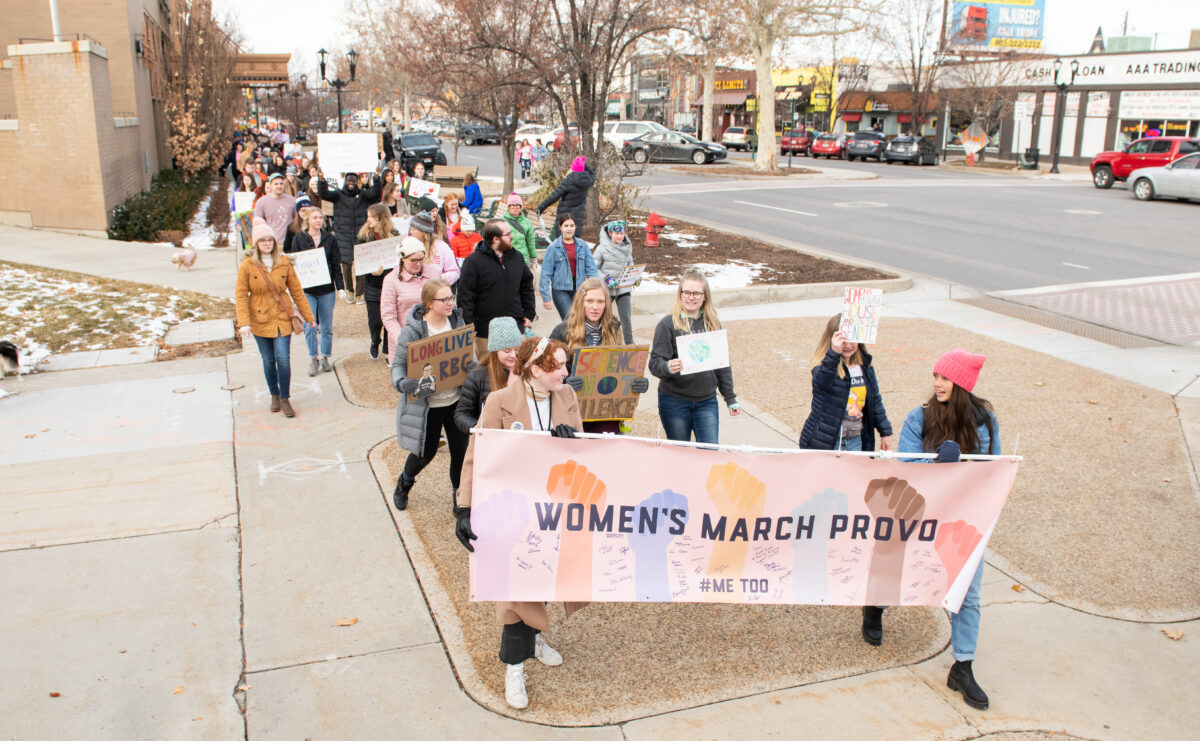Research shows women need social safety, 45% feel unsafe
- Christine Wright, of Provo, holds up her sign along with other attendees as they cheer during the Women’s Wave Rally held Jan. 19, 2019, outside the Historic Utah County Courthouse in Provo.
- Community members march from Pioneer park to the Provo Historic Courthouse during the Women’s March Provo event Saturday, Jan. 18, 2020, along Center Street in Provo.
- Participants at Provo’s Women’s Day event engage in an exercise to find their power space on Saturday, March 4, 2023.

Isaac Hale, Daily Herald file photo
Christine Wright, of Provo, holds up her sign along with other attendees as they cheer during the Women's Wave Rally held Jan. 19, 2019, outside the Historic Utah County Courthouse in Provo.
According to the Utah Women & Leadership Project, 45.6% women in Utah feel unsafe. The UWLP released a brief Thursday examining social safety, which refers to reliable social connection, social belongingness, social inclusion, social recognition and social protection, according to the brief’s findings.
Almost half of women reported having experienced chronic unsafety at some point in their lives, and 13.6% said they were currently experiencing chronic unsafety. The most frequent contexts for chronic unsafety were romantic and household relationships. Rates of chronic unsafety were significantly higher among women who were unmarried, non-heterosexual/non-cisgender, had very low income, had experienced adult assault or childhood abuse, or had been suicidal. Additionally, women who reported having been “shunned by a religious group” reported higher rates of unsafety.
In all, 57.8% of women occupied no marginalized social categories (i.e., white, heterosexual, cisgender and not low-income), 22.6% of women occupied at least one marginalized category and 19.6% occupied more than one. Women who occupied one or more marginalized categories reported lower social safety.
A woman’s marginalization status predicted her social safety independently of social isolation and exposure to ostracization, disrespect, childhood adversity and community violence. Thus, occupying a marginalized social category can interfere with women’s social safety independently of their direct experiences of exclusion, shame, and violence.
Social isolation showed the strongest negative association with social safety while social safety was imperiled by ostracization, marginalization and everyday disrespect.

Johnny Morris, Special to the Daily Herald
Community members march from Pioneer park to the Provo Historic Courthouse during the Women’s March Provo event Saturday, Jan. 18, 2020, along Center Street in Provo.
Individuals with lower social safety reported significantly greater physical health problems, greater depressive symptoms, and greater anxiety symptoms.
In all, 31% of participants reported prior suicidal ideation and 13.5% reported a previous suicide attempt. Women who were below the sample mean for social safety had approximately twice the odds of suicidal ideation and suicide attempts as women who were above the mean.
“For over three decades, health psychologists have documented disproportionately high mental and physical health problems among individuals who are socially marginalized due to their race/ethnicity, sexual identity, gender identity, or socioeconomic status,” Lisa Diamond, the brief’s author, wrote. “The prevailing explanation for these health disparities has been “minority stress,” defined as the cumulative chronic stress provoked by everyday instances of discrimination, unfair treatment, and shame.”
This predicts that the poorest health outcomes should be observed in those with the greatest minority stressors, yet studies suggest that this model might be oversimplified, according to Diamond, a professor of Psychology and Gender Studies at the University of Utah.
Although marginalized individuals with high exposure to mistreatment do have compromised mental/physical health, so do those with low exposure.

Courtesy Daniel Pugmire
Participants at Provo's Women's Day event engage in an exercise to find their power space on Saturday, March 4, 2023.
“Because links between stigma and health do not depend solely on the frequency and magnitude of overt stigma-related stressors, we need to better understand how stigma harms the health of individuals in Utah and beyond,” Diamond said.
She concludes that social safety may be the missing piece.
“People need to know that those around them will approve, protect, and care about them, more than to suspect that they might,” Diamond said. “Accordingly, workplaces, schools, and organizations should consider where and when members of the community might feel uncertain of their belonging.”
Diamond noted that social safety is more pressing in the wake of the pandemic. Many individuals now spend a significant amount of their workday or school day online, working alone instead of with others.
“Remote work has numerous advantages regarding accessibility and flexibility, but the loss of face-to-face social contact may erode individuals’ access to the basic nourishment of affirmative social connection,” Diamond said.
Diamond concludes that workplaces, schools and organizations that primarily interact online should seek and promote opportunities for individuals to connect personally and authentically with one another, in person, and in settings that promote relaxation, comfort and unguardedness.
“As Utah policymakers and community leaders continue seeking ways to enhance Utah women’s economic opportunities, health status, and social standing, we must treat social safety with equal importance,” Diamond said. “Accordingly, health promotion efforts should adopt a “safety first” approach that begins by identifying whether individuals have sufficient and reliable access to affirmative and protective social relationships that provide them with consistent validation, affirmation, protection, and belonging.”
The full brief can be found at http://utwomen.org.






